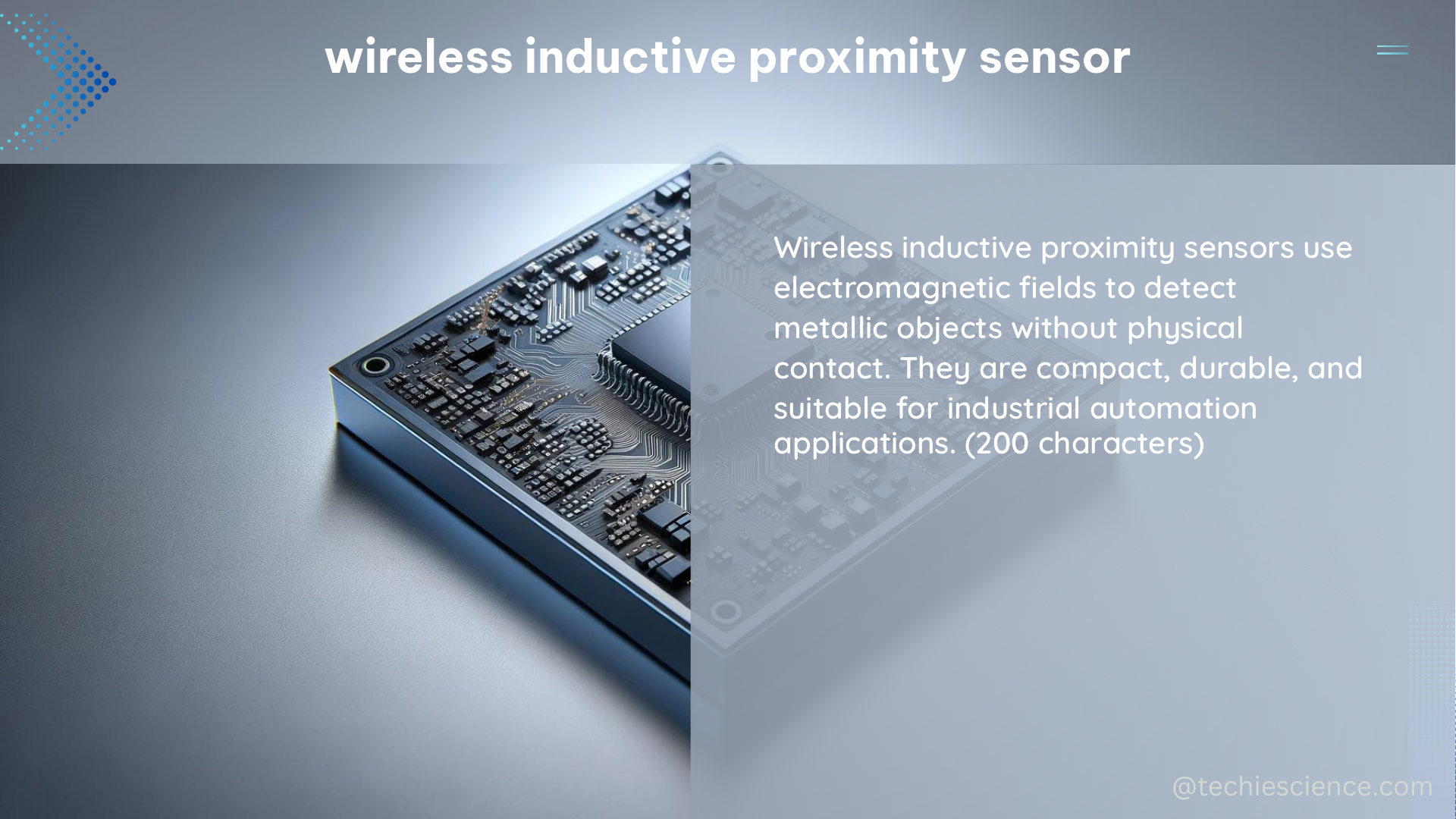Wireless inductive proximity sensors are advanced devices that utilize electromagnetic induction to detect the presence of metallic objects without physical contact. These sensors have become increasingly popular in various industrial applications, offering reliable and precise detection capabilities. In this comprehensive guide, we will delve into the technical details, implementation strategies, and a step-by-step approach to building your own wireless inductive proximity sensor project.
Understanding the Principles of Wireless Inductive Proximity Sensors
Wireless inductive proximity sensors operate on the principle of electromagnetic induction. These sensors contain a coil that generates an electromagnetic field, which is affected by the presence of a metallic object within the sensor’s detection range. When a metallic object enters the sensor’s field, it alters the magnetic flux, inducing a change in the coil’s impedance. This change is then detected by the sensor’s electronic circuitry, triggering a corresponding output signal.
The key factors that influence the performance of wireless inductive proximity sensors include the sensor’s coil design, the target material’s properties, and the distance between the sensor and the target. The sensor’s coil geometry, number of turns, and the driving frequency all contribute to the sensor’s sensitivity and detection range. Additionally, the target material’s electrical conductivity and magnetic permeability play a crucial role in the sensor’s response.
Technical Specifications of Wireless Inductive Proximity Sensors

One of the widely used wireless inductive proximity sensors is the NBB0,8-5GM25-E2 model from Pepperl + Fuchs. This sensor offers the following technical specifications:
| Specification | Value |
|---|---|
| Switching Distance | 0.8 mm for unmagnetized ferrous targets |
| Operating Temperature Range | -25°C to +70°C |
| Supply Voltage Range | 10-30V |
| Switching Frequency | Up to 500 Hz |
| Output Type | PNP NO |
| Sensor Dimensions | 25 mm diameter, 5 mm height |
To connect this sensor to a data acquisition device, such as the NI cDAQ-9188 and NI-9215 module, a load resistor is necessary to limit the current flow and prevent short-circuiting. For a 10V power supply, a 1000 ohms resistor can be used, while for higher voltage supplies, a voltage divider with two resistors is recommended.
Addressing Temperature Drift in Wireless Inductive Proximity Sensors
One of the challenges faced by wireless inductive proximity sensors is temperature drift, which can affect the sensor’s accuracy and stability. To address this issue, researchers have proposed an analog-digital mixed measurement method based on a two-dimensional look-up table.
This method separates the inductance and resistance components of the sensor, reducing temperature drift and generating quantitative outputs. By establishing a two-dimensional look-up table and conducting an operating principle analysis, the online computational complexity is reduced, and power consumption is minimized. Additionally, a real-time built-in self-test (BIST) function is designed to ensure reliable and stable measurements.
Building a DIY Wireless Inductive Proximity Sensor Project
To build your own wireless inductive proximity sensor project, follow these steps:
-
Select a Suitable Sensor: Choose a wireless inductive proximity sensor that meets your project’s requirements, such as the NBB0,8-5GM25-E2 model from Pepperl + Fuchs.
-
Power Supply: Ensure a stable power supply within the sensor’s specified voltage range. For the NBB0,8-5GM25-E2, the supply voltage range is 10-30V.
-
Load Resistor: Connect a load resistor to limit the current flow and prevent short-circuiting. For a 10V power supply, a 1000 ohms resistor can be used, while for higher voltage supplies, a voltage divider with two resistors is recommended.
-
Data Acquisition Device: Connect the sensor to a data acquisition device, such as the NI cDAQ-9188 and NI-9215 module, to capture and process the sensor’s output signal.
-
Software Setup: Configure the software to read and interpret the sensor’s output signal. This may involve setting up communication protocols, data processing algorithms, and visualization tools.
-
Testing and Calibration: Test the sensor in various conditions to ensure accurate and reliable detection. Perform necessary calibrations to optimize the sensor’s performance based on the target material and environmental factors.
-
Enclosure and Mounting: Design and fabricate an enclosure to protect the sensor and its associated electronics. Ensure proper mounting and positioning of the sensor to achieve the desired detection range and coverage.
-
Integrated Temperature Compensation: Implement the analog-digital mixed measurement method with a two-dimensional look-up table to address temperature drift and ensure stable and reliable measurements.
-
Real-Time Built-In Self-Test (BIST): Integrate a BIST function to continuously monitor the sensor’s performance and detect any potential issues or failures.
By following these steps, you can build a robust and reliable wireless inductive proximity sensor project that can be tailored to your specific application requirements.
Conclusion
Wireless inductive proximity sensors are powerful tools that offer contactless detection of metallic objects, making them invaluable in various industrial and automation applications. By understanding the underlying principles, technical specifications, and implementation strategies, you can design and build your own wireless inductive proximity sensor project that meets your specific needs. Remember to address the challenges of temperature drift and ensure reliable and stable measurements through advanced techniques like the analog-digital mixed measurement method and real-time BIST.
References
- Inductive proximity sensor reading – NI Community. https://forums.ni.com/t5/Multifunction-DAQ/Inductive-proximity-sensor-reading/td-p/2604155
- An Analog-Digital Mixed Measurement Method of Inductive Proximity Sensor. https://www.ncbi.nlm.nih.gov/pmc/articles/PMC4732063/
- Sensors for daily life: A review – ScienceDirect.com. https://www.sciencedirect.com/science/article/pii/S2666351121000425
- Pepperl + Fuchs NBB0,8-5GM25-E2 Datasheet. https://www.pepperl-fuchs.com/global/en/classid_1529.htm?view=productdetails&prodid=55524
- NI cDAQ-9188 and NI-9215 Datasheet. https://www.ni.com/en-us/support/model.cdaq-9188.html

The lambdageeks.com Core SME Team is a group of experienced subject matter experts from diverse scientific and technical fields including Physics, Chemistry, Technology,Electronics & Electrical Engineering, Automotive, Mechanical Engineering. Our team collaborates to create high-quality, well-researched articles on a wide range of science and technology topics for the lambdageeks.com website.
All Our Senior SME are having more than 7 Years of experience in the respective fields . They are either Working Industry Professionals or assocaited With different Universities. Refer Our Authors Page to get to know About our Core SMEs.